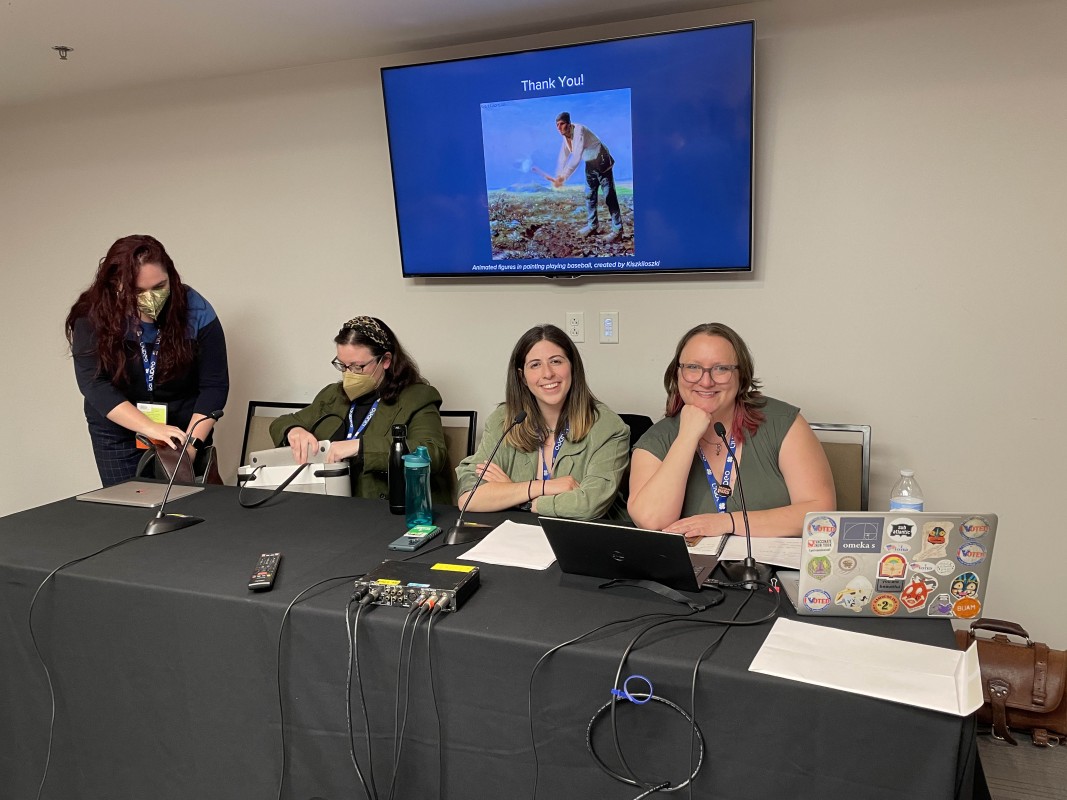Data points: How inclusive metadata fosters diversity in museum collections
History major Eliana Ellerton plays an important role in Binghamton University Art Museum archive project

Behind every sculpture, painting and drawing in the Binghamton University Art Museum is a hidden stream of data: the name of the artist and the work, the materials, the composition.
Metadata — literally data about data — helps channel that stream, explained Binghamton University Art Museum intern Eliana Ellerton, a senior history major who will finish her master’s degree in 2024 through the 4+1 program. Since last year, Ellerton has been working with Art Museum Curator of Collections and Exhibitions Claire Kovacs on formulating inclusive metadata guidelines, or protocols on how the museum approaches diversity within its archives.
“It is crucial to have these documents to ensure that these artists are represented accurately and that we are held accountable for how we treat them within our internal systems,” Ellerton said.
Data within an archive system allows archivists to find the information they need quickly, such as the names of works by a particular artist, or from a particular region or time period. Inclusive metadata collects information relating to diverse populations within the archives, such as cultural, race or ethnic origin, sexual orientation and gender identity, and more.
Currently, the museum has three designated areas of artist identity and interest: Black; BIPOC, for Black, Indigenous and People of Color; and LGBTQ, for lesbian, gay, bisexual, transgender and queer identities. Ellerton also began to track women and Jewish artists, although those categories aren’t yet in use.
Let’s say, for example, that the museum has a piece from a Haitian artist who identifies as Black; that item of information would be added to the metadata, along with BIPOC interest, which covers many different identities. If someone wanted to create an exhibit centered on Black artists, this particular artist and his work would come up in the archive search.
“It’s a tool for the museum to use when they’re trying to gauge the diversity in the collection,” Ellerton said. “In this project, we wanted to make sure that we were speaking with communities that may have been historically overlooked.”
During the guideline drafting process, Ellerton also reached out to campus communities for their input, including the Q Center, the Multicultural Resource Center and the Services for Students with Disabilities Office, and also investigated how the Binghamton University Libraries approach metadata.
“The core of this project is about diversity and making sure that people are represented in a careful way,” Ellerton said. “Language can change, and the way that people perceive their own cultures and identities can change, as well as the culture itself.”
This spring, Ellerton began putting the new guidelines into place, adding the metadata into the archival database. That involves researching every artist in the collection and adding the appropriate categories.
With 1,500 artists, it’s a project that will continue for years, as interns delve into books, obituaries, family statements and more to find the appropriate information. So far, Ellerton has compiled research on 120 of the artists.
Recently, Ellerton and Kovacs presented their work at the Museum Association of New York Conference in Syracuse. The 75-minute panel discussion also included Kelli Bogan and Emily Cooper from the National Baseball Hall of Fame and Museum in Cooperstown.
The project also opened doors for Ellerton, who received support from Harpur Edge in attending the Syracuse conference. This summer, she will work as an intern at the Metropolitan Museum of Art, assisting its library with a similar project.
“To the general public, museums have been considered relatively mysterious; they’re beacons of knowledge that showcase things from the past,” she said. “But in reality, a lot of museums are trying to move into the future as centers of community engagement, and trying to actively change systems of harm. We really want to be places that people can visit and feel safe, feel heard and feel seen.”
